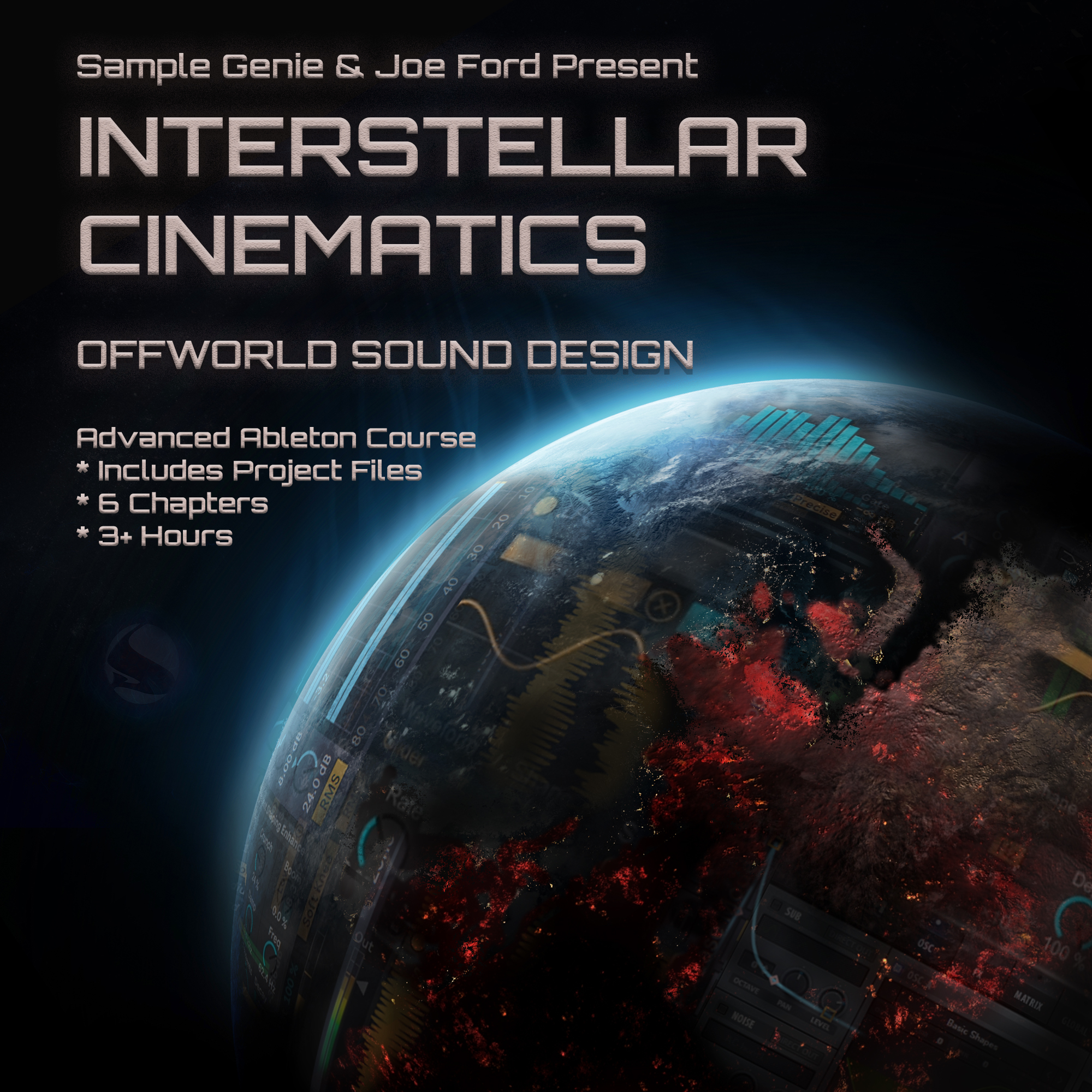Analysis of S5E01: Disprove – FRQNCS Tutorial
- This topic has 5 replies, 4 voices, and was last updated 6 years, 10 months ago by ,
 Robert.
Robert.
-
AuthorPosts
-
-
2017-08-22 at 15:54:16 #29022,
 HarryModerator
HarryModeratorI wanted to get this one done ASAP so I could try and keep current with the S5 videos as they are released. Next one I should have posted is S1E04: FD – Bass Sequencing, possibly this week. Anyways, now for my notes from this episode.
—–
WATCH NOTES
The tune is an attempt at mixing jump-up & neurofunk. It was written in F minor. Also there is a lot going on in the video, at times I found it challenging to understand what is going on. Actually hoping some others can explain bits, or articulate questions a bit better.DAW used: Ableton Live – most of this can be replicated in other DAWs, although there were some native plug-ins that I’m not sure of alternatives for, namely Erosion, Amp (a Softube logo on it though?), and Saturator
00:55 – Buses- Drums bus is several sub folders that route to the drum bus:
- Kick
- K. Splash
- Snare
- Hats
- Percs
- Percs VA
- Bass is one bus, sub on a separate bus
- Synths/FX is the next bus
- Up/Downs – these are uplifters & downlifters/impacts
- Intro bus – this is a new idea to me, having a bus dedicated to just the intro sounds
- Vocal bus
02:00 – Drum bus- Signal chain is: compressor (stock Ableton compressor) → EQ (Fabfilter Pro-Q) → Inflator (Sonnox Oxford Inflator) → Transient shaper (Sonnox Oxford TransMod)
- Info on inflator here: https://www.sonnox.com/plugin/oxford-inflator-v3
- 03:00 – Kick group goes to drum bus, has following chain: compressor (stock) → EQ (stock EQ-8) → transient shaper (Oxford TransMod) → spectrum analyzer (stock plug-in)
- Two kick layers, one a clean kick from a sample pack, the other sampled from a hip-hop track, has some EQ’ing done to it
- 04:30 – the K. Splash group, likes to have some splash in his tunes to give an energetic sound
- Two layers of splashy drum hits
- 05:50 – snare group, two layers of snare sounds
- 06:00 – shows how he made the first layer, is actually three samples layered
- FX chain: compressor (stock) → EQ (EQ-8) → 2nd EQ (FF Pro-Q) → Saturator (stock Saturator) → transient shaper (TransMod) → reverb
- 07:20 – main snare layer actually has more FX on it: comp → EQ-8 → saturator
- 08:00 – something snare related, with three EQ’s doing precise work
- Why are there multiple copies of the same plug-ins? Is this the idea that the next in the chain catches any extra work?
- 08:50 – he thinks high peaks in higher frequencies sound harsh, does not like how they sound
- 09:25 – hats group: glue compressor → compressor → compressor
- I think compressor #1 is sidechained to kicks, and compressor #2 is sidechained to snares
- Hats comprised of loops & one-hits, to give rhythm to the track
- Also a ride cymbal in this group
- 11:00 – percussion group, looks like it just has a compressor on it
- Shuffles, various percussive hits, mix of one-shots & chops of loops, shakers
- 12:25 – percussion VA gorup
- Drum fills & cowbells
12:40 – bassline group
- Much longer FX chain
- The bassline is made up of resampled basses, uses audio files
- 13:30 – the FX chain: EQ-8 → Frequency Splitter (explained below) → EQ-8 → Saturator → EQ-8 → FF Pro-Q → Limiter
- Frequency split is as follows:
- Highs: EQ-3 → Vinyl Distortion
- Mids: EQ-3 → LFO → Erosion → Amp
- Sub: EQ-3 → Utility (to make the signal mono)
- 14:45 – demonstrating how the FX chain changes bass samples
- 15:50 – seems like the bassline is comprised of different bass samples, but all of them are processed through the same chain
- Folder of resampled basses had over 80 sounds
- 6:15 – starts going in to individual bass tracks and explains the different processing on each
- So a big folder of resampled basses to pull from, then in the track these start to get unique processing
- I think the key to all this is not the exact FX chains & processing, but how & why he does this
- 17:00 – little triplet bass attack stab
- 17:55 – talking bassline
- Three Erosion plug-ins on this
- Seemed fairly complex processing to me
- 19:30 – another bassline sound
- 20:20 – another bass stab
- 21:00 – explaining the bass group’s FX chain
- 22:00 – sub bass, basically just a sine wave with a little processing
22:30 – synths/FX group- This group is for short samples, stabs and vocals hits
24:05 – Up/Downs group for up lifters and down lifters- Usually just use random samples, stretching and/or pitching them
- Says he likes to us “EDM or really cheesy sample packs” for these sounds
- Doesn’t feel there is a need to make your own
25:10 – intro sounds group- Says he’s not really a big intro guy, goes for a simple intro
- Uses Omnisphere, picks a random sound and adjusts parameters
- 26:15 – adding an arpeggiator from Albino 3
- Uses a different up lifter than in the Up/Downs group
- Says you can make good intros without over doing things
30:00 – vocals group- Did a sampling session processing the main vocal sample in different ways, sort of like the bass resampling from earlier
- 31:30 – trying random patches in NI Guitar Rig, for sound design
31:45 – looking at mixdown- Actually turns down volume for the groups, likes to saturate rather than use a limiter
- 33:00 – recommends working with mono bassline samples, then layer in stereo copies
33:15 – looking at master channel- Does not really care about clipping, mastering chain takes care of that
- Likes a slight touch of distortion (CamelPhat), then Ozone at end
- In Ozone, uses EQ, Stereo Imager, and Maximizer modules
34:45 – looking at return tracks- First return track is for transients, with kick and snare sent to it, then processing with NI’s Transient Master, then TransMod
- Next track is a reverb return, just using Ableton’s stock reverb
36:00 – explains how he utilizes the spectrum analyzer
36:30 – explaining his take on sound design- Bass made in Virust TI, but says he will show how to make a similar bass in Massive
- Chord based with distortion
- “The magic comes from the distortion.”
- After the Virus, he uses the same FX chain used earlier within his bass group
- 39:20 – Massive version
- Key is checking the overtones and then trying to replicate in Massive
- Focus on sub and low mid range
- 42:00 – trying a distortion plug-in inserted after Massive
—–
Thoughts & Questions:Erosion is an “effect degrades the input signal by modulating a short delay with filtered noise or a sine wave. This adds noisy artifacts or aliasing/downsampling-like distortions that sound very ”digital.”” There is some interesting info about non-Ableton alternatives in these threads:
- https://www.kvraudio.com/forum/viewtopic.php?p=6200582
- https://www.gearslutz.com/board/electronic-music-instruments-electronic-music-production/636264-can-anyone-recommend-equivalent-abletons-saturator-erosion-audio-unit-plugs.html
How often does Disprove use the same bass FX chain? Is this something I would want to try? It could create a tailored sound, at least for however long that particular chain is used for, e.g. 3~4 months of sketches and tracks that used the chain. The rates & amounts would be different in each project, I imagine. Also makes me think I should create more FX containers in Bitwig, and channel strips in Logic.
What are the jump-up elements of the track? Can’t say I am super familiar with current trends, so maybe it’s how the drums were designed, and the bassline?
"Knowledge kept is knowledge lost." - Bobbito Garcia
- Drums bus is several sub folders that route to the drum bus:
-
2017-08-22 at 19:34:01 #29024,
 GENIE HQKeymaster
GENIE HQKeymasterWe really need to compile these into some kind of document for people to reference, would you be interested in doing that?
And would anybody else think this might be helpful to have on file?Likewise if anybody here has thoughts / questions of their own after watching the tutorials and reading these detailed breakdown’s please pitch them in!
PS, the links and stuff on ‘erosion’ is awesome, such a great tool and used by so many people – having an emulation for non Ableton users is a great idea.
Big ups harry 🙂
-
2017-08-23 at 00:33:34 #29030,
 HarryModerator
HarryModeratorThanks! I’m up for compiling these, can email to figure out how & where.
Also echoing the call for others to weigh in on the tutorials & ask questions. Recently heard something along the lines of “inspiration is good, but inspiration followed by action is better.”
"Knowledge kept is knowledge lost." - Bobbito Garcia
-
-
2017-08-25 at 14:45:56 #29049,
 jhelyar@livecoukParticipant
jhelyar@livecoukParticipantI’d love to see these notes available somewhere instead of by luck stumbling across them in these forums.
-
2017-08-28 at 01:10:21 #29061,
 HarryModerator
HarryModeratorWorking on figuring out how we want to do this.
"Knowledge kept is knowledge lost." - Bobbito Garcia
-
-
2017-09-05 at 21:24:25 #29394,
 RobertParticipant
RobertParticipantThanks for the detailed breakdown, I really appreciate it. The information about and quest for alternatives for erosion are great; it’s great to see how it works sad ways to emulate it.
-
-
AuthorPosts
- You must be logged in to reply to this topic.


